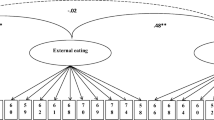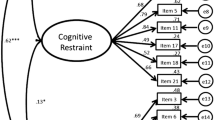Abstract
Most previous studies have failed to replicate the original factor structure of the 26-item version of the Eating Attitudes Test (EAT-26) among community samples of adolescents. The main objective of the present series of four studies (n = 2178) was to revisit the factor structure of this instrument among mixed gender community samples of adolescents using both exploratory structural equation modeling (ESEM) and confirmatory factor analysis (CFA). First, results from the ESEM analyses provided satisfactory goodness-of-fit statistics and reliability coefficients for a six-factor model of the EAT with 18 items (EAT-18) closely corresponding to the original seven-factor structure proposed for the 40-item version of the EAT. Second, these analyses were satisfactorily replicated among a new sample of community adolescents using CFA. The results confirmed the factor loading and intercept invariance of this model across gender and age groups (i.e., early and late adolescence), as well as the complete invariance of the EAT-18 measurement model between ethnicities (i.e., European versus African origins) and across weight categories (i.e., underweight, normal weight and overweight). Finally, the last study provided support for convergent validity of the EAT-18 with the Eating Disorder Inventory and with instruments measuring global self-esteem, physical appearance, social physique anxiety and fear of negative appearance evaluation.
Similar content being viewed by others
References
Anderson, D. A., Lundgren, J. D., Shapiro, J. R., & Paulosky, C. A. (2004). Assessment of eating disorders: review and recommendations for clinical use. Behavior Modification, 28, 763–782.
Asparouhov, T., & Muthén, B. (2009). Exploratory structural equation modeling. Structural Equation Modeling, 16, 397–438.
Belon, K. E., Smith, J. E., Bryan, A. D., Lash, D. N., Winn, J. L., & Gianini, L. M. (2011). Measurement invariance of the eating attitudes test-26 in Caucasian and Hispanic women. Eating Behaviors, 12, 317–320.
Berland, N. W., Thompson, J. K., & Linton, P. H. (1986). Correlation between the EAT-26 and the EAT-40, the eating disorders inventory, and the restrained eating inventory. International Journal of Eating Disorders, 5, 569–574.
Carter, P. I., & Moss, R. A. (1984). Screening for anorexia and bulimia nervosa in a college population: problems and limitations. Addictive Behaviors, 9, 417–419.
Chamay-Weber, C., Narring, F., & Michaud, P.-A. (2005). Partial eating disorders among adolescents: a review. Journal of Adolescent Health, 37, 417–427.
Chen, F. F. (2007). Sensitivity of goodness of fit indexes to lack of measurement. Structural Equation Modeling, 14, 464–504.
Cheung, G. W., & Rensvold, R. B. (2002). Evaluating goodness-of fit indexes for testing measurement invariance. Structural Equation Modeling, 9, 233–255.
Cole, T. J., & Lobstein, T. (2012). Extended international (IOTF) body mass index cut-offs for thinness, overweight and obesity. Pediatric Obesity, 7, 284–294.
Cole, T. J., Bellizzi, M., Flegal, K., & Dietz, W. (2000). Overweight and obesity worldwide: international establishing a standard definition for child survey. British Medical Journal, 320, 1240–1243.
Cole, T. J., Flegal, K., Nicholls, D., & Jackson, A. (2007). Body mass index cut offs to define thinness in children and adolescents: international survey. British Medical Journal, 335, 194–197.
Crawford, J. R., Garthwaite, P. H., & Slick, D. J. (2009). On percentile norms in neuropsychology: proposed reporting standards and methods for quantifying uncertainty over percentile ranks of test scores. The Clinical Neuropsychologist, 23, 1173–1195.
Enders, C. K. (2010). Applied missing data analysis. New York: Guilford.
Fabrigar, L. R., Wegener, D., MacCallum, R., & Strahan, E. (1999). Evaluating the use of exploratory factor analysis in psychological reserach. Psychological Methods, 4, 272–299.
Fairburn, C. G., Cooper, Z., & Shafran, R. (2003). Cognitive behaviour therapy for eating disorders: a “transdiagnostic” theory and treatment. Behaviour Research and Therapy, 41, 509–528.
Finney, S. J., & DiStefano, C. (2006). Non-normal and categorical data in structural equation modeling. In G. R. Hancock & R. O. Mueller (Eds.), Structural Equation Modeling: A Second Course (pp. 269–314). Greenwich: IAP.
Garfinkel, P. E., & Newman, A. (2001). The eating attitudes test: twenty-five years later. Eating and Weight Disorders, 6, 1–24.
Garner, D. M., & Garfinkel, P. E. (1979). Eating attitudes test: an index of the symptoms of anorexia nervosa. Psychological Medicine, 9, 273–279.
Garner, D. M., Olmstead, M. P., Bohr, Y., & Garfinkel, P. E. (1982). The eating attitude test: psychometric features and clinical correlates. Psychological Medicine, 12, 871–878.
Garner, D. M., Olmstead, M. A., & Polivy, J. (1983). Development and validation of a multidimensional eating disorder inventory for anorexia nervosa and bulimia. International Journal of Eating Disorders, 2, 15–34.
Golden, N. H., Katzman, D. K., Kreipe, R. E., Stevens, S. L., Sawyer, S. M., Rees, J., et al. (2003). Eating disorders in adolescents: position paper of the society for adolescent medicine. Journal of Adolescent Health, 33, 496–503.
Hart, E. H., Leary, M. R., & Rejeski, W. J. (1989). The measurement of social physique anxiety. Journal of Sport & Exercise Psychology, 11, 94–104.
Hu, L., & Bentler, P. (1999). Cutoff criteria for fit indexes in covariance structure analysis: conventional criteria versus new alternatives. Structural Equation Modeling, 6, 1–55.
Jacobi, C., Hayward, C., de Zwaan, M., Kraemer, H. C., & Agras, W. S. (2004). Coming to terms with risk factors for eating disorders: application of risk terminology and suggestions for a general taxonomy. Psychological Bulletin, 130, 19–65.
Karpowicz, E., Skärsäter, I., & Nevonen, L. (2009). Self-esteem in patients treated for anorexia nervosa. International Journal of Mental Health Nursing, 18, 318–325.
Krane, V., Stiles-Shipley, J. A., Waldron, J., & Michalenok, J. (2001). Relationships among body satisfaction, social physique anxiety, and eating behaviors in female athletes and exercisers. Journal of Sport Behavior, 24, 247–264.
Leichner, P., Steiger, H., Puentes-Neuman, G., Perreault, M., & Gottheil, N. (1994). Validation d’une échelle d’attitudes alimentaires auprès d’une population québécoise francophone. Revue Canadienne de Psychiatrie, 39, 49–54.
Little, T. D., Lindenberger, U., & Nesselroade, J. R. (1999). On selecting indicators for multivariate measurement and modeling with latent variables: when “good” indicators are bad and “bad” indicators are good. Psychological Methods, 4, 192–211.
Lundgren, J. D., Anderson, D. A., & Thompson, J. K. (2004). Fear of negative appearance evaluation: development and evaluation of a new construct for risk factor work in the field of eating disorders. Eating Behaviors, 5, 75–84.
MacCallum, R. C., Roznowski, M., & Necowitz, L. B. (1992). Model modifications in covariance structure analysis: the problem of capitalization on chance. Psychological Bulletin, 111, 490–504.
MacCallum, R. C., Zhang, S., Preacher, K. J., & Rucker, D. D. (2002). On the practice of dichotomization of quantitative variables. Psychological Methods, 7, 19–40.
Maïano, C., Morin, A. J. S., Ninot, G., Monthuy-Blanc, J., Stephan, Y., & Vallée, P. (2008). A short and very short form of the physical self-inventory for adolescents: development and factor validity. Psychology of Sport & Exercise, 9, 830–847.
Maïano, C., Morin, A. J. S., Monthuy-Blanc, J., Garbarino, J.-M., & Stephan, Y. (2009). Eating disorders inventory: assessment of its construct validity in a non-clinical French sample. Journal of Psychopathology and Behavioral Assessment, 31, 387–404.
Maïano, C., Morin, A. J. S., Eklund, R. C., Monthuy-Blanc, J., Garbarino, J.-M., & Stephan, Y. (2010). Construct validity of the social physique anxiety scale in a French adolescent sample. Journal of Personality Assessment, 92, 1–10.
Maïano, C., Morin, A. J. S., Monthuy-Blanc, J., & Garbarino, J.-M. (2010). Construct validity of the fear of negative appearance evaluation scale in a French adolescent’s community sample. European Journal of Psychological Assessment, 26, 19–27.
Marsh, H. W., Ellis, L., Parada, R., Richards, G., & Heubeck, B. (2005). A short version of the self description questionnaire ii: operationalizing criteria for short-form with new applications of confirmatory factor analyses. Psychological Assessment, 17, 81–102.
Marsh, H. W., Hau, K.-T., & Grayson, D. (2005). Goodness of fit evaluation in structural equation modeling. In A. Maydeu-Olivares & J. McArdle (Eds.), Psychometrics. A Festschrift to Roderick P. McDonald. Hillsdale: Erlbaum.
Marsh, H. W., Muthén, B. O., Asparouhov, T., Lüdtke, O., Robitzsch, A., Morin, A. J. S., et al. (2009). Exploratory structural equation modeling, integrating CFA and EFA: application to students’ evaluations of university teaching. Structural Equation Modeling, 16, 439–476.
McDonald, R. P. (1970). Theoretical foundations of principal factor analysis, canonical factor analysis, and alpha factor analysis. British Journal of Mathematical and Statistical Psychology, 23, 1–21.
Meredith, W. (1993). Measurement invariance, factor analysis and factorial invariance. Psychometrika, 58, 525–543.
Micali, N., & House, J. (2011). Assessment measures for child and adolescent eating disorders: a review. Child & Adol;escent Mental Health, 16, 122–127.
Mintz, L., & O’Halloran, S. E. (2000). The eating attitudes test: validation with DSM-IV eating disorder criteria. Journal of Personality Assessment, 74, 489–503.
Morin, A. J. S., & Maïano, C. (2011a). Cross-Validation of the short form of the physical self-inventory (PSI-S) using exploratory structural equation modeling (ESEM). Psychology of Sport & Exercise, 12, 540–554.
Morin, A. J. S., & Maïano, C. (2011b). Cross-validation of the very short form of the Physical Self-Inventory (PSI-VS): invariance across genders, age groups, ethnicities and weight statuses. Body Image, 8, 404–410.
Morin, A. J. S., Marsh, H. W., & Nagengast, B. (in press). Exploratory structural equation modeling: An introduction. In G. R. Hancock & R. O. Mueller (Eds.), Structural equation modeling: A second course (2nd ed.). Greewich: IAP.
Muthén, L. K., & Muthén, B. O. (2010). Mplus user’s guide. Los Angeles: Muthén & Muthén.
Nasser, M. (1997). The EAT speaks many languages: review of the used of the EAT in eating disorders research. Eating and Weight Disorders, 2, 174–181.
Neumark-Sztainer, D., Story, M., Hannan, P. J., Perry, C. L., & Irving, L. M. (2002). Weight-related concerns and behaviors among overweight and nonoverweight adolescents: implications for preventing weight-related disorders. Archives of Pediatrics & Adolescent Medicine, 156, 171–178.
Raciti, M. C., & Norcross, J. C. (1987). The EAT and EDI: screening, interrelationships, and psychometrics. International Journal of Eating Disorders, 6, 579–586.
Satorra, A., & Bentler, P. (1999). A scaled difference Chi-square test statistic for moment structure analysis. Technical Report University of California, Los Angeles. http://preprints.stat.ucla.edu/260/chisquare.pdf.
Schoemaker, C., Van Strien, T., & Van der Staak, C. (1994). Validation of the eating disorder inventory in a nonclinical population using transformed and untransformed responses. International Journal of Eating Disorders, 15, 387–393.
Smink, F. R. E., van Hoeken, D., & Hoek, H. W. (2012). Epidemiology of eating disorders: Incidence, prevalence and mortality rates. Current Psychiatry Reports. Advance online publication. doi: 10.1007/s11920-012-0282-y
Smith, G., McCarthy, D., & Anderson, K. (2000). On the sins of short-form development. Psychological Assessment, 12, 102–111.
Stice, E. (2002). Risk and maintenance factors for eating pathology: A meta-analytic review. Psychological Bulletin, 128, 825–848.
Streiner, D. L. (2003). Starting at the beginning: an introduction to coefficient alpha and internal consistency. Journal of Personality Assessment, 80, 99–103.
Thurnstone, L. L. (1947). Multiple-factor analysis. Chicago: University of Chicago Press.
van Strien, T., & Ouwens, M. (2003). Validation of the Dutch EDI-2 in one clinical and two nonclinical populations. European Journal of Psychological Assessment, 19, 66–84.
Vandenberg, R. J., & Lance, C. E. (2000). A review and synthesis of the measurement invariance literature: suggestions, practices, and recommendations for organizational research. Organizational Research Methods, 3, 4–70.
Wildes, J. E., Emery, R. E., & Simons, A. D. (2001). The roles of ethnicity and culture in the development of eating disturbance and body dissatisfaction: a meta-analytic review. Clinical Psychology Review, 21, 521–551.
Author information
Authors and Affiliations
Corresponding author
Additional information
Christophe Maïano and Alexandre J. S. Morin contributed equally to this article and their order was determined at random: both should be considered first authors. Part of this manuscript was prepared while A.J.S.M was a visiting scholar at the Aix-Marseille University.
Electronic supplementary material
Below is the link to the electronic supplementary material.
ESM 1
(DOC 299 kb)
Rights and permissions
About this article
Cite this article
Maïano, C., Morin, A.J.S., Lanfranchi, MC. et al. The Eating Attitudes Test-26 Revisited using Exploratory Structural Equation Modeling. J Abnorm Child Psychol 41, 775–788 (2013). https://doi.org/10.1007/s10802-013-9718-z
Published:
Issue Date:
DOI: https://doi.org/10.1007/s10802-013-9718-z




